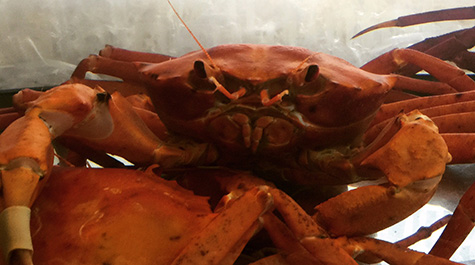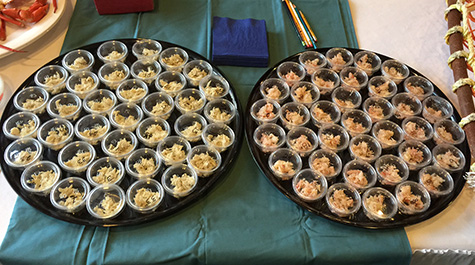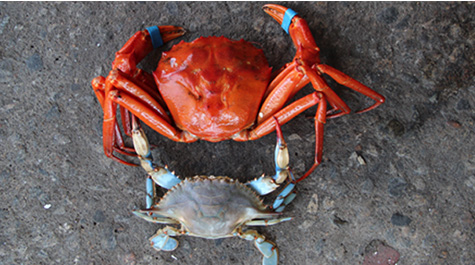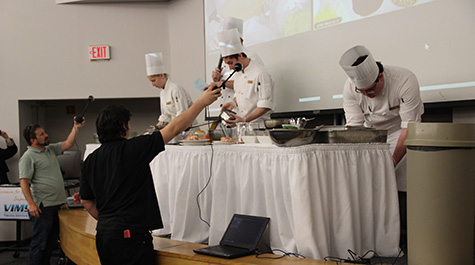One crab, two crab, red crab, new crab
VIMS hosts 23rd annual Chef’s Seafood Symposium
Chefs from across Hampton Roads visited the Virginia Institute of Marine Science last week for a daylong symposium designed to introduce a new player in the local seafood game—the red crab.
The annual education program—sponsored by VIMS Marine Advisory Services, Virginia Sea Grant, and the American Culinary Federation’s Virginia Chefs Association—brings together culinary professionals, culinary students, scientists, and representatives from the seafood industry and related businesses for a day of learning, cooking, and tasting.
This year highlighted a newcomer to local seafood markets, the Atlantic red crab Chaceon quinquedens. This deep-sea species resembles a snow crab and is caught using hive-shaped traps deployed along the edge of the continental shelf. The crabs are harvested sustainably, available year-round, and arrive at the local markets fresh, not frozen.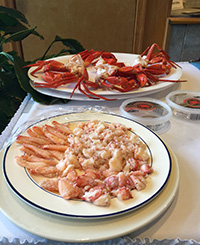
Robert Fisher, VIMS extension staff affiliated with Virginia Sea Grant, kicked off the symposium by providing some background on the red crab as a species. Fisher explained the crabs are found in the deep cold waters of the Atlantic, and live along the edge of the North American continental shelf from Nova Scotia down along the East Coast and into the Gulf of Mexico.
Fisher explained that the water temperature where the crabs live—at depths from about 650 to 6,000 feet—is a constant 38 degrees Fahrenheit, thereby producing a cold-water crab with superior taste and texture.
The Marine Stewardship Council certified the species as sustainable in 2009—meaning all retail and food service partners can be assured of the viability of the stock and the endurance of a well-managed fishery. Fisher describes the crab as sweeter than snow crab with a texture much like the Dungeness. “The crab’s purported sweet flavor and meaty texture has the potential to be marketed as a premium product,” he says.
Fisher says the main challenge of taking a deep-water crab into the live market is keeping them alive and healthy. “To keep red crab healthy for five or more days in a live market, we have to develop entirely new ways for managing their water chemistry: controlling for temperature, ammonia concentrations, pH, and many other factors,” he says.
“In an area famous for a preference for blue crab, the red crab compares quite well with its blue counterpart,” Fisher says. “However, blue crab is found in brackish water while red crab resides in salt water, so sodium levels in red crab are higher than blue, and due to different habitats, the red crab has more protein and less total fat.”
Symposium organizer Lisa Ayers Lawrence, VIMS extension staff affiliated with Virginia Sea Grant, says chefs—especially young chefs—aren’t necessarily familiar with the seafood items they’re serving, and may even be hesitant to serve seafood. “They need to know what’s local, in season, sustainable, and how best to handle and prepare the seafood,” she says.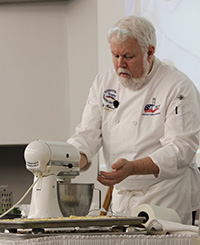
“Besides being a healthy, low-fat, high-protein, delicious food, seafood is also an important Virginia natural resource and very much tied to coastal Virginia’s culture,” says Lawrence.
John Williams, a fisherman that catches red crab, and Jim Casey, owner of Casey Seafood in Newport News, gave the students some insight about how red crab is caught and distributed, where and when to buy it, and answered questions from the chefs.
Event participants also had the opportunity to taste red and blue crab and compare the two. Then, members from the Virginia Chef’s Association apprenticeship program engaged in a friendly cooking competition where they incorporated red crab into three different dishes, with a crab-salad pita sandwich ultimately winning the grand prize.
Culinary Educator John Maxwell finished the day with a seafood cooking demonstration where he walked through several different dishes incorporating red crab, including red crab cannoli and red crab cheesecake.
Lawrence says the goal of the symposium is to provide the chefs with information about local Virginia seafood to encourage them to serve it and make informed decision about what they serve. “We definitely want to continue to provide these connections to the culinary community,” she says.


